Disclosure: We may earn commissions if you purchase products after clicking on a link from our site.
Do you want to learn how to catch yellowtail snapper? Would you like to learn fishing tips that will let you take a bucketful of yellowtail snapper home? Would you like to learn how to catch yellowtail snapper in the Florida Keys?
Yellowtail snapper is fished all year round and this constant fishing pressure can make it challenging sometimes to catch yellowtails. In this article, we share information about successfully fishing for yellowtails, as well as the fishing tackle to use, the baits, and more fishing information to have enough yellowtails for dinner.
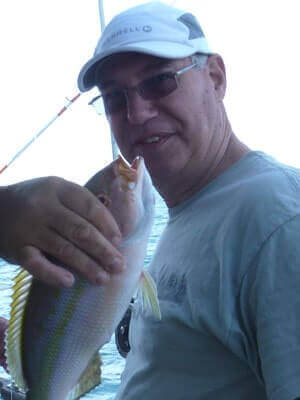
Table of Contents
How To Catch Yellowtail Snapper
Yellowtail snapper is a small reef fish found from the Atlantic coast of Massachusetts, through Florida, the Gulf of Mexico, Bahamas, the Caribbean, and Brazil. You can find yellowtails as deep as 300 feet in coastal waters. There are many fishing techniques that are used by anglers to catch yellowtails. Additionally, there are a number of factors to affect fishing for yellowtails especially in the Florida Keys.
1. Chumming
Most anglers use a chum bag filled with pieces of fish to attract yellowtails. Usually, when the boat is anchored, anglers will place the chum bags out on the side of the boat. After a waiting period of about 15 minutes, allowing the chum to settle in the water and get yellowtails comfortable, then they will put a line in the water.
One of the factors that affect fishing for yellowtails, is the clarity of the water or the lack thereof. When you are learning how to catch yellowtail snapper, remember this: when the water is cloudy and rough, that is the best scenario for fishing yellowtails.
It will be more challenging to catch yellowtails on a clear and calm day when the fish can clearly see the fishing line. Yellowtail snapper has very good eyesight. They are fished all year and have come to equate the fishing line to danger. If they see the fishing line when the water is calm and clear, it will be more difficult to get them to bite.
On the other hand, if it is turbulent weather with strong winds and the water is rough and cloudy, fish usually will go into a feeding frenzy and it will be more difficult for them to clearly see the fishing line. This will make it easier to catch yellowtail snappers. When learning how to catch yellowtail snapper, this is one important fishing tip to remember.
2. Baitcasting
Baitcasting is a versatile fishing method that can be effectively used to target yellowtail snapper, especially when fishing in reef areas or over structures where these fish are abundant. Anglers typically employ baitcasting reels paired with medium to medium-light rods, offering the necessary sensitivity to detect subtle bites while still providing enough backbone to handle the fight.
When baitcasting for yellowtail snapper, anglers use a variety of bait options, including live baitfish like pilchards or ballyhoo, as well as cut bait such as squid or shrimp. The key to success lies in presenting the bait naturally and enticingly to the snapper. Anglers should carefully adjust their baitcasting rigs to match the conditions and depth of the water they’re fishing in, ensuring that the bait remains within the strike zone.
Patience and finesse are crucial when baitcasting for yellowtail snapper, as these fish can be wary and selective feeders. Anglers should be prepared to experiment with different bait presentations and casting techniques to maximize their chances of success.
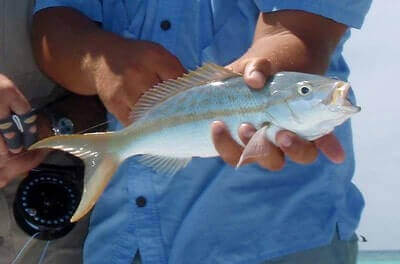
3. Drift Fishing
Drift fishing is another effective technique for targeting yellowtail snapper, especially when fishing over expansive reef systems or along drop-offs. Anglers can drift with the current while presenting baited hooks or jigs at various depths to intercept passing schools of yellowtail snapper.
This method allows anglers to cover a wide area and explore different depths until they locate actively feeding fish. Common baits used for drift fishing include live or cut baitfish, squid, and shrimp. Anglers should pay close attention to the speed and direction of the drift to ensure their baits remain in the strike zone for optimal success.
Adjusting the weight of the rig and the length of the leader can help maintain the desired presentation throughout the drift. For more comprehensive guidance on drift fishing for yellowtail snapper, anglers can refer to resources provided by the National Oceanic and Atmospheric Administration (NOAA): NOAA Fishing Guidelines.
4. Vertical Jigging
Vertical jigging is a dynamic and exciting fishing method that can be highly effective for targeting yellowtail snapper, particularly in deeper waters or areas with strong currents. Anglers deploy specialized jigging lures, such as metal jigs or butterfly jigs, and work them vertically through the water column to mimic the erratic movements of injured baitfish.
This technique requires anglers to actively jig their rods up and down while keeping a close eye on their line for any subtle strikes or bites. Vertical jigging allows anglers to cover a significant portion of the water column and can be particularly productive when yellowtail snapper are holding at mid-water depths or suspended above structure. Anglers can experiment with different jigging techniques, retrieve speeds, and jig colors to determine what triggers the most strikes from yellowtail snapper.
5. Bottom Fishing
Bottom fishing is a popular and effective method for targeting yellowtail snapper. Anglers typically use baited hooks or small jigs presented near the seabed where yellowtail snapper are known to feed. Common bait options include squid, shrimp, and small fish like pilchards or ballyhoo.
Anglers can fish from anchored boats or drift over productive areas while keeping their bait close to the bottom. Yellowtail snapper are known to inhabit reef structures, wrecks, and rocky bottoms, so anglers should focus their efforts in these areas. Patience and attention to detail are essential when bottom fishing for yellowtail snapper, as they can be selective feeders and may require subtle presentations to entice bites.
How to Make Chum For Fishing
Making chum for fishing is not a difficult process. Use the fish baitfish that fish you want to catch always eat. Cut them into chunks and strips to easily get the liquid to flow into the water and permeate it. This will get to the fish you want to target and they will come to the chum for the bait to eat.
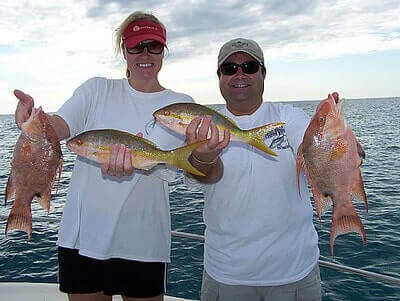
Best Baits For Yellowtail Snapper
- Live Shrimp
Live shrimp are highly effective bait for targeting yellowtail snapper, renowned for their enticing scent and natural movements that attract these fish. When using live shrimp for yellowtail snapper fishing, anglers typically rig them on a small hook with a fluorocarbon leader to provide stealth and reduce visibility in clear water conditions.
The presentation of live shrimp should mimic natural behavior, allowing them to drift with the current or be slowly retrieved to entice strikes from yellowtail snapper. It’s essential to handle live shrimp carefully to keep them lively and active, as lively shrimp are more likely to attract attention from hungry snapper.
Anglers can target yellowtail snapper around structures such as reefs, wrecks, and ledges, where these fish tend to congregate. Patience is key when using live shrimp as bait, as yellowtail snapper can be cautious feeders, requiring anglers to present their bait with finesse and precision. By mastering the art of presenting live shrimp effectively, anglers can increase their chances of success when targeting yellowtail snapper.
2. Ballyhoo
Ballyhoo is a popular bait choice among anglers targeting yellowtail snapper due to its natural appearance and enticing scent. These slender baitfish are often rigged whole or in strips on a hook, allowing them to mimic the movement of injured or struggling prey in the water, which can trigger aggressive strikes from yellowtail snapper.
When using ballyhoo as bait for yellowtail snapper fishing, anglers typically employ a variety of rigging techniques, including nose hooking, tail hooking, or butterfly rigging, to optimize presentation and increase hookup rates. Ballyhoo can be fished at various depths, from near the surface to deeper waters around reef structures where yellowtail snapper is commonly found.
Additionally, anglers may enhance the effectiveness of ballyhoo by bringing or marinating them in fish attractants to intensify their scent trail and appeal to hungry snappers. Proper storage and handling of ballyhoo are crucial to maintaining their freshness and maximizing their effectiveness as bait.
Anglers should ensure that ballyhoo are kept chilled and properly thawed before use to preserve their natural appearance and scent. By utilizing ballyhoo as bait for yellowtail snapper fishing, anglers can increase their chances of success in hooking these prized sportfish.
3. Bonito
Bonito, a type of small tuna, can serve as effective bait for yellowtail snapper fishing. Despite being a predatory species themselves, bonito can attract yellowtail snapper with their lively movement and strong scent. Anglers often cut bonito into chunks or strips and use them as chunk bait or cut bait.
This method involves presenting the bait on a hook, either with a bottom rig or a drifting rig, to entice yellowtail snapper to bite. Bonito’s oily flesh releases scent into the water, attracting yellowtail snapper from a distance. Additionally, the flash and movement of bonito chunks can mimic the behavior of wounded or struggling prey, enticing predatory instincts in yellowtail snapper.
Anglers may also use bonito chunks in conjunction with chumming techniques to create a feeding frenzy and draw more yellowtail snapper to the area. Properly storing bonito and ensuring it remains fresh is essential for maximizing its effectiveness as bait. Anglers should keep bonito on ice or in a cooler to preserve its freshness and scent. By utilizing bonito as bait for yellowtail snapper fishing, anglers can increase their chances of success in targeting these prized gamefish.
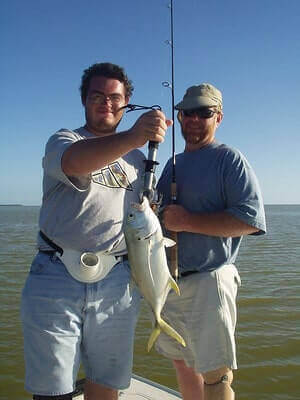
4. Squid
Squid is a popular and effective bait choice for yellowtail snapper fishing due to its strong scent, durability, and versatility. Anglers often use whole squid or squid strips as bait when targeting yellowtail snapper. Squid’s natural oils and scent are attractive to yellowtail snapper, helping to lure them to the baited hook.
When using whole squid, anglers can either hook the squid through the body or thread it onto the hook to create an enticing presentation. Alternatively, squid strips can be cut into smaller pieces and used as bait. These strips flutter in the water, mimicking the movement of natural prey and enticing strikes from hungry yellowtail snapper.
Squid is also relatively tough, allowing it to withstand multiple strikes from smaller fish without easily tearing apart. Anglers can fish squid baits on a variety of rigs, including bottom rigs, dropper rigs, or sliding sinker rigs, depending on the fishing conditions and preferences.
Additionally, squid can be enhanced with additional scent attractants or bait oils to further entice yellowtail snapper. Proper storage of squid is important to maintain its freshness and effectiveness as bait, typically by keeping it on ice or in a bait cooler until ready for use
5. Dead Glass Minnows
Dead glass minnows can be an effective bait choice for yellowtail snapper fishing, offering anglers a convenient option with proven success. Glass minnows, also known as bay anchovies, are small, silver-colored baitfish commonly found in coastal waters.
While live glass minnows are prized for their natural movement and scent, dead glass minnows can still attract yellowtail snapper when properly presented. Anglers often rig dead glass minnows on a variety of rigs, including dropper rigs, sabiki rigs, or jig heads, depending on the fishing conditions and depth of the water.
To maximize their effectiveness, anglers may add additional scent attractants or bait oils to the dead glass minnows to enhance their appeal to yellowtail snapper. Dead glass minnows can be particularly useful when live bait is unavailable or when fishing in areas where live bait is challenging to keep alive. Proper storage of dead glass minnows is crucial to maintain their freshness and effectiveness as bait, typically by keeping them on ice or in a bait cooler until ready for use
6. Sardines
Sardines serve as an excellent bait choice for yellowtail snapper fishing, prized for their oily flesh and strong scent that can attract these elusive predators. Yellowtail snappers are known to have a preference for oily baits, and sardines fit the bill perfectly.
These small, silvery fish are abundant in many coastal waters and can be caught or purchased fresh or frozen from bait shops. When rigging sardines for yellowtail snapper, anglers often employ a variety of techniques, including whole bait presentation, chunk bait, or fillets, depending on the fishing conditions and preferences of the fish.
Sardines can be rigged on a range of rigs, such as dropper rigs, Carolina rigs, or jig heads, to target yellowtail snapper at various depths and locations. To maximize their effectiveness, anglers may also choose to brine or marinate sardines in additional scents or attractants before use. Proper storage of sardines is crucial to maintain their freshness and prevent them from spoiling, typically by keeping them on ice or in a bait cooler until ready for use.
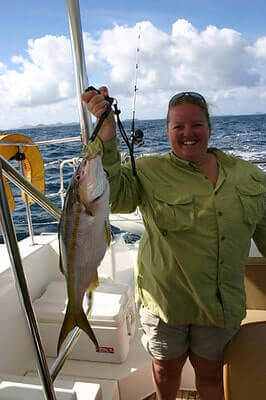
Yellowtail Snapper Tackle Setup
A light tackle will get the job done when learning how to catch yellowtail snapper. A 6 to 7-foot medium action spinning rod spooled with a 12- to 15-pound test line and a 15- or 20-pound fluorocarbon leader will work. Additionally, a number 1 or 2 hooks will work well.
How To Catch Yellowtail Snapper In the Florida Keys
The yellowtail snapper is one of the popular fishes to target in the Florida Keys. They can be easily found and are tasty fish for eating. When fishing for yellowtails in the Florida Keys, there are some factors that have to be taken into consideration.
The wind direction, current, clarity of the water, and sunlight. Believe it or not: it is better to fish for yellowtails during rough and turbulent weather when the water will be rough and cloudy. This makes it easier to cast multiple lines into the water as it will be more difficult for yellowtail snappers to see the lines.
Yellowtails have good eyesight and will easily see the fishing line on a calm and clear day with clear and calm waters. Anglers use a clear 12 to 15-pound fluorocarbon leader on clear and calm days and drop one line at a time. Yellowtails are fished all year round and they have learned to associate the fishing line with danger. They will be skittish and reluctant to bite if they see the fishing line.
Most anglers use chum bags when fishing for yellowtails in the Florida Keys. They usually drop the chum bags into the water and wait for about 15 minutes for the fish to be comfortable and eat the fish pieces from the chum bag. After this period, when they are not skittish, then anglers will drop their lines to target the yellowtails. The yellowtail snapper size limit In Florida is 12 inches
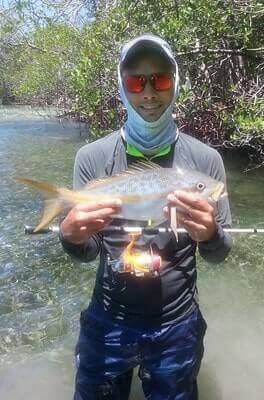
Yellowtail Snapper Fishing Tips
- The calmness and clarity of the water play a crucial role when fishing for yellowtail snapper. If it is a calm day and the water is calm and clear, it will be more difficult to catch yellowtail snappers as they will easily see the fishing line with their very good eyesight.
2. If the day is windy and rough, the weather will also be rough and may be cloudy. This makes it easier to catch yellowtails as they won’t easily see the fishing line. This presents the opportunity to put many fishing lines in the water to catch yellowtails.
3. Anglers use chum bags filled with fish and fish parts to attract yellowtails. After throwing the chum bags into the water, anglers will wait for about 15 minutes to get the fish comfortable before putting fishing lines in the water.
4. A clear 12-15 pound fluorocarbon leader is best when fishing for yellowtail snapper.
5. The best scenario is for the chum slick to travel behind the boat as anglers will fish off the back of the boat.
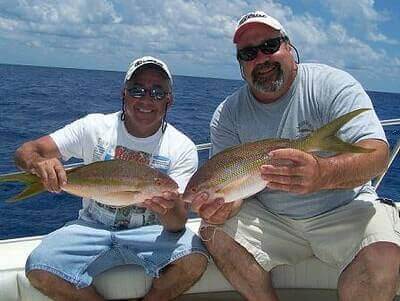
6. Anglers use an oatball to target yellowtails when fishing in deep waters. They will use rolled oats and saltwater to make an oatball that is used to cover the filet.
7. Fishing for yellowtail snapper during the winter is one of the best times because there are higher winds, bigger waves, and overcast skies that will make the water rough and cloudy. Cloudy water will make it harder for the fish to see your lines thereby allowing you to put more lines in the water.
8. Always point your tip toward the water and free-spool the fishing line allowing the bait to flow naturally in the current at the speed of the chum.
9. Bring a landing net when fishing for yellowtail snappers to ensure “flags” don’t escape when you are reeling them in. “Flags” is the term anglers use to refer to larger than regular-sized yellowtails. Their forked tails resemble flags fluttering in the breeze. The smaller yellowtail snappers are called “tails”.

10. If in the process of reeling a hooked yellowtail into the boat, it gets chopped in half by a barracuda, don’t throw the carcass back into the water. Other fish will get spooked by the bloody remains and then they will stop biting.
11. A 6 to 7-foot medium action spinning rod spooled with a 12- to 15-pound test line and 15- or 20-pound fluorocarbon leader will work.
The Bottom Line
Yellowtail snappers are one of the most sought-after fish in the Florida Keys and other areas on the Atlantic coast all the way down to Brazil. Why? They are tasty, plentiful, and relatively easy to catch.
Chumming, drift fishing, baitcasting, still fishing, and fly fishing are some of the fishing methods that can be used when learning how to catch yellowtail snapper.
In this article, we discussed the fishing methods, the bait, and lures, the yellowtail tackle setup, as well as shared fishing tips to help you take more of this delicious fish home for dinner. If you catch red snapper and mangrove snappers, you may want to read how to catch red snapper, how to catch lane snapper, how to catch mutton snapper, how to catch vermillion snapper, and how to catch mangrove snapper.